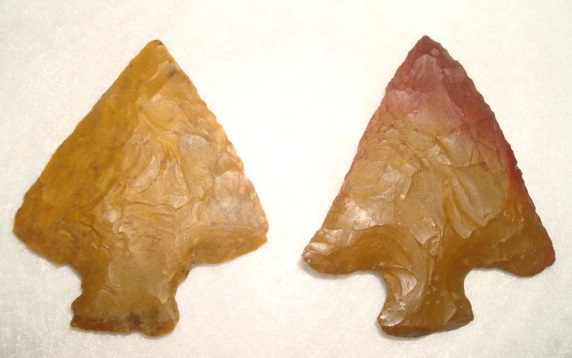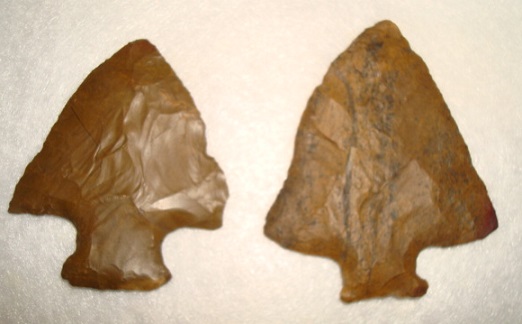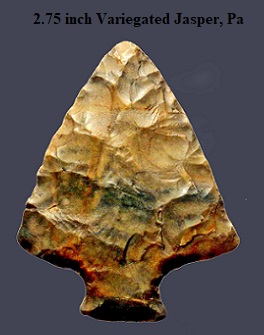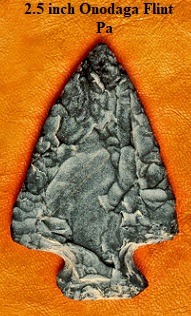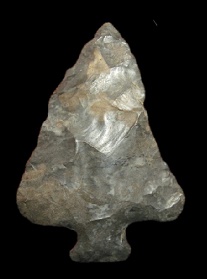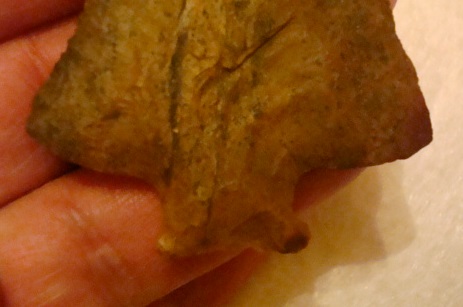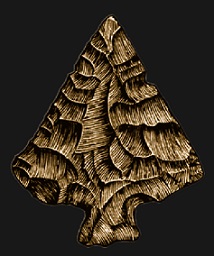Name Details:
Named By: John Witthoft
Named For:
Perkiomen Creek, Eastern Pennsylvania.
Date Identified: 1953
Type Site:
Perkiomen
Cluster: Susquehanna Cluster
Date:
Cultural Period:
3,700 - 2,900 B.P.
Late Archaic to Early Woodland
Neoglacial
Susquehanna Soapstone Culture
Glacial Period:
Culture:
Outline is Representative of Size and Shape:
Description of Physical Characteristics and Flaking Pattern:
This is a
broad medium asymmetrical triangular expanding stem point with a flattened
plano convex cross section. The blade may vary from straight to excurvate. The shoulders are commonly described as barbed, however, one shoulder may range from horizontal to having a downward slope while the other shoulder is commonly sloped upwards. The stem is expanding to bulbous and is commonly off center
and is always narrower than the shoulders. The base is primarily straight. Grinding is commonly seen on the hafting region of
this point. Broad course
percussion flaking is used to form and thin the blade with fine
pressure flaking used to form the base and shoulders. Pressure
flaking is rarely seen on the blade.
Size
Measurements: Length - 50 to 200 mm (average 55
to 76 mm), Stem Length - 7 to 11 mm, Width
- 45 to 75 mm, Stem Width - 15 to 22 mm, Neck Width - 12
to 18 mm, Thickness - 6 to 8 mm.
Distribution:
Distribution Comments:
This point is primarily found in Schuylkill Valley of eastern New York and into the eastern
borders of the Susquehanna
River valley. Frequency decreases into the Hudson River basin, Delaware River valley,
the Niagara Peninsula of Ontario, and surrounding regions. May be found with decreasing frequency into Virginia, eastern Michigan, and Ohio.
Rarely these points are found greater than 200 miles from the source
material.
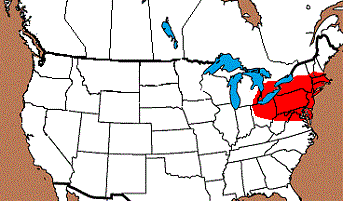
Additional Comments:
Found further south, and possibly an extension of the distribution, is the Dismal Swamp point
found in Virginia and North Carolina.
Paul Frey notes that Perkiomen begin with a
triangular preform with a slightly square base. The preforms are
extremely thin created by course broad percussion flaking. Percussion
flaking is continued thinning the point leaving large broad flakes across
both faces of the point. Fine pressure flaking may be used to form the
base and shoulders, but are non-existent on the blade. The base is
always smaller than the shoulders with grinding present on the basal edge
and along the both shoulders. The shoulders are asymmetrical with one
shoulder always being longer than the other one. The shoulders can be
horizontal and can vary from being loped upwards, horizontal, or loped
downward, but are rarely the same size. The cross section is a thin
flat plano convex with one side being flat and the other side being convex,
median ridges and lenticular cross section are not present on this type.
These points were primarily used as knives rather than projectile points.
Point Validity: Valid Type
Witthoft is
a pioneering anthropologist who retired as a professor for the Department of Anthropology at the University of Pennsylvania. He serves as Chief Curator for the
Pennsylvania State Museum and as State Archaeologist for the State of Pennsylvania. He was an expert in the archaeology of Pennsylvania. This point was named in a professional publication and has many professional references. This is considered a valid type.
.
Age Details:
Pictures Provided By:
A special thanks to Paul Frey and Lee W. for providing pictures and additional
information.
References: (See Reference Page, Entry Number):
29, 30, 37, W10, W11
Perkiomen Projectile Point, Perkiomen Arrowhead
